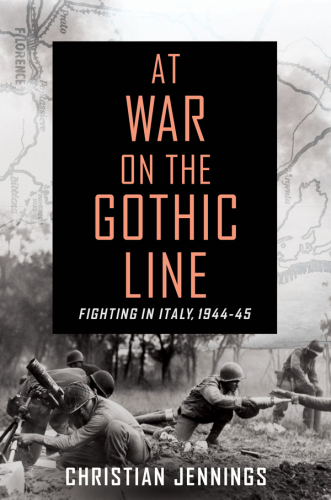
At War on the Gothic Line
Fighting in Italy, 1944-45
کتاب های مرتبط
- اطلاعات
- نقد و بررسی
- دیدگاه کاربران
نقد و بررسی

Starred review from December 15, 2015
Journalist and war correspondent Jennings (Bosnia's Million Bones: Solving the World's Greatest Forensic Puzzle, 2013, etc.) chronicles the World War II battles in Italy in 1944 and 1945. Laced through the story are the viewpoints of fascinating individuals involved in the fighting. At the same time, the author gives us a broad overview, reporting battle details clearly and providing vivid descriptions of the impenetrable German line. Trying to drive the Germans out of Italy was the job of a truly diverse army. There were soldiers from India, America, Brazil, New Zealand, Poland, and Canada. They were arrayed against the Gothic Line, which ran from Rimini on the east coast to Carrara on the west. The German army, under Field Marshal Albert Kesselring, had escaped the fighting in the south because American Gen. Mark Clark decided the glory of liberating Rome was more important than cutting off the German army. Kesselring made potent use of Italy's geography to dig into the mountains and set up minefields, and he even buried tank turrets as bunkers. The Allies split into three units to move up the center of the line to Bologna, in the west toward the Tuscan coast, and in the Adriatic toward Ravenna. Ready to attack, the Allies were suddenly ordered to divert some divisions to the invasion at Nice, a move that took all pressure off Hitler, gave Stalin free rein in his westward push, and guaranteed that the fight for the Gothic Line would be bloody. The struggle seemed never-ending. The author takes to task those generals who ignored orders, causing extended fighting and untold deaths. He also includes a helpful section at the end, "What Became of the Characters in the Book." An excellent book refreshingly unlike most tedious, confusing war stories. Jennings brings his easy journalistic style and thorough fact finding to one of the most desperate conflicts of the war, teaching us how war stories should be written.
COPYRIGHT(2015) Kirkus Reviews, ALL RIGHTS RESERVED.

March 15, 2016
The title refers to the defensive line set up across northern Italy in 1944 by German Field Marshall Kesselring after Allied forces had driven the Germans out of Sicily and southern Italy. Investigative journalist Jennings does an excellent job of examining the efforts to dislodge the Germans by interweaving the personal experiences of several soldiers with the broader aspects of the Italian campaign. The Allied armies were a diverse group; numerically, British and American forces dominated, but Canadians, Poles, Indians, and Italian partisans also played significant roles. Many of the troops were battle-hardened veterans of the earlier phases of fighting in Italy, but the assaults against the Gothic Line were of an altogether different order. The Germans were well trained, extremely well entrenched, and the severe Italian winter and mountainous terrain favored defensive warfare. Although Jennings clearly admires the bravery and tenacity of Allied forces, he strongly criticizes what he views as the strategic blunder of commanders that led to stalemates in some sectors. This is a fine survey of a frequently neglected and still controversial element of WWII.(Reprinted with permission of Booklist, copyright 2016, American Library Association.)

























دیدگاه کاربران